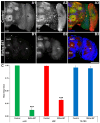An Environmentally-Friendly RNAi Yeast-Attractive Targeted Sugar Bait Turns off the Drosophila suzukii Rbfox1 Gene
- PMID: 40429193
- PMCID: PMC12111878
- DOI: 10.3390/insects16050481
An Environmentally-Friendly RNAi Yeast-Attractive Targeted Sugar Bait Turns off the Drosophila suzukii Rbfox1 Gene
Abstract
Spotted wing drosophila (SWD), Drosophila suzukii (Diptera: Drosophilidae), are invasive vinegar flies of East Asian origin that are an increasingly global threat to the small fruit industry. It is essential that new classes of eco-friendly insecticides and cost-effective strategies for SWD control are developed. Here, we describe the preparation of a strain of RNA interference (RNAi) Saccharomyces cerevisiae expressing shRNA that specifically targets the SWD RNA-binding Fox protein 1 (Rbfox1) gene. The yeast effectively silences the SWD Rbfox1 gene, resulting in significant loss of fly neural activity. Laboratory trials demonstrated that the RNAi yeast can be mixed with soda, which functions as SWD attractive targeted sugar bait (ATSB) that can be delivered in a soda bottle feeder. The ATSB, mixed with yeast that was heat-killed prior to suspension in the ATSB, resulted in 92 ± 1% mortality of SWD flies that consumed it, yet had no impact on non-target dipterans. Rbfox.687 yeast delivered in ATSB feeders may one day be a useful component of integrated SWD control programs.
Keywords: berry; control; eco-friendly; fruit crop; insect; insecticide; integrated pest management; spotted wing drosophila.
Conflict of interest statement
The funders of this investigation had no role in the design of the study, in the collection, analyses, or interpretation of data, in the writing of the manuscript; or in the decision to publish the results. M.D.S. and K.M. are inventors on a pending U.S. patent application related to this work, which was filed by Indiana University; however, this did not impact their analysis of the data described herein or the decision to publish it. The other authors have no competing interests to declare.
Figures



References
-
- Reyes J.A., Lira-Noriega A. Current and future global potential distribution of the fruit fly Drosophila suzukii (Diptera: Drosophilidae) Can. Entomol. 2020;152:587–599. doi: 10.4039/tce.2020.3. - DOI
-
- Walsh D.B., Bolda M.P., Goodhue R.E., Dreves A.J., Lee J., Bruck D.J., Walton V.M., O’Neal S.D., Zalom F.G. Drosophila suzukii (Diptera: Drosophilidae): Invasive pest of ripening soft fruit expanding its geographic range and damage potential. J. Integr. Pest Manag. 2011;2:G1–G7. doi: 10.1603/ipm10010. - DOI
-
- Asplen M.K., Anfora G., Biondi A., Choi D.-S., Chu D., Daane K.M., Gibert P., Gutierrez A.P., Hoelmer K.A., Hutchison W.D., et al. Invasion biology of spotted wing Drosophila (Drosophila suzukii): A global perspective and future priorities. J. Pest Sci. 2015;88:469–494. doi: 10.1007/s10340-015-0681-z. - DOI
-
- Cai P., Song Y., Yi C., Zhang Q., Xia H., Lin J., Zhang H., Yang J., Ji Q., Chen J. Potential host fruits for Drosophila suzukii: Olfactory and oviposition preferences and suitability for development. Entomol. Exp. Appl. 2019;167:880–890. doi: 10.1111/eea.12840. - DOI
-
- Sarkar N., Rhodes E.M., Spies J., Roubos C.R., Little B.A., Sial A.A., Fanning P.D., Isaacs R., Liburd O.E. Evaluation of non-target effects of OMRI-listed insecticides for management of Drosophila suzukii Matsumura in berry crops. J. Appl. Entomol. 2020;144:12–25. doi: 10.1111/jen.12713. - DOI
LinkOut - more resources
Full Text Sources
Molecular Biology Databases
Research Materials

